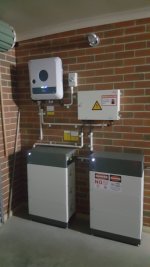Since we're doing a show and tell, here is an old photo of my system. Sorry, it's a bit wet to take a new photo today.
This is a penny pinching setup. The larger cells are from an EV kit that I bought cheap at an auction; the smaller cells are also ex-EV, from an accidental short circuit that rendered many cells unsuitable for EV use, yet are doing OK as part of the house battery. These cells date back to 2009, and have been used in this system since 2015.
The original 45 cells (144 V nominal) were split into 16 for a friend, and the remaining 29 were not quite enough for 16S2P. Hence the Frankenstein battery. One 160 Ah cell (the larger ones) is paired with two 100 Ah cells (the smaller ones), and there is also a "quad" (four 100 Ah cells in parallel). So it's really 14S2P + 3P + 4P, or if you count the 100 Ah cells as 60% the capacity of the 160 Ah, then it's 14S2P + 1S2.2P + 2.4P! In retrospect, I should have divided the cells into one 15S string (enough for a 48 V nominal system, like Pylontech and many others), and one 15S2P system. I have had replacement cells for years, I just need to find the time to install them. They are radically different in size (very tall), so I have to redo the shelving to accommodate them.
Note the pairs of 50 mm² cable to each bank of cells; this is necessary to satisfy the requirement that the battery cables can withstand a dead short (8 kA in this case) for 10 seconds without catching fire. These tired old cells could not put out a quarter of that current any more.
You can see strapping and threaded rods holding the cell groups together. This is something you have to do for prismatic cells, to stop them from swelling, even with no mishaps.
To the left of the photo you can see the edge of a large toolbox that used to house the lead acid battery that was this system's predecessor. That was a 24 V system. There are still cells in there (more 100 Ah cells), running a few lights for redundancy.
The white circles with two terminals are EV200 contactors, capable of 200 A DC at hundreds of volts. They were obtained cheap from Ebay, I suspect from failed EV or similar companies. Some were lightly used, others brand new. The Big Red Button at the left drops all the contactors, isolating the battery, inverter, and a smaller AC contactor drops the AC-in.
The Blue Sky box on the right has been replaced with a second 5 kVA 4 kW inverter. The two in parallel run all the house loads except for the oven (rarely used now that we have a convection microwave), water heater, and ducted air conditioning. I have mused about putting the water heater on this system, but when you need a lot of hot water (winter, rain), there isn't much solar power, so I don't bother. The inverters run fully patched firmware, which overcomes a number of limitations of these inverters when using an LFP battery.
The white boxes at the very top house the PV breakers. I now have 2S14P of panels (it's a low PV voltage system, unusual these days). All positions are full now. 5.65 kW nominal of panels. They are all tiny panels by today's standards; 195 W, 200 W, and 215 W. The 6 215 W panels are mounted at 45° inclination and are on top of the carport on the south side of the house. The 45° angle is to make these perform better in winter, when you need PV power the most.
There are two small computers there. One is a Beaglebone Black, like a Raspberry Pi but supposed to be better for the number of serial ports or some such. It handles monitoring, and networks to my laptop (Ethernet cable or WiFi). The other computer drives all the contactors and talks to the Cell Management Units, one is on top of each pair/group of cells. They communicate via industrial fibre (a cheap plastic based fibre suitable for short runs).
With the cover on, the case is featureless, and has the same proportionality as the
monolith from Arthur C. Clarke's 2001: A Space Odyssey.
